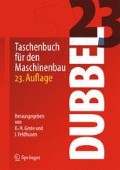Zusammenfassung
Korrosion ist die physikochemische Wechselwirkung zwischen einem Metall und seiner Umgebung, die zu Veränderungen der Eigenschaften des Metalls führt und die zu erheblichen Beeinträchtigungen der Funktion des Werkstoffes, der Umgebung oder des technischen Systems, von dem diese einen Teil bilden, führen kann [1]. Diese Definition ersetzt frühere Betrachtungsweisen der Korrosion, in denen oft sehr unklar der Korrosionsprozess selbst, das Ergebnis in Form der Korrosionsprodukte oder der Korrosionsschaden gemeint waren. Insbesondere ergibt sich daraus, dass die Korrosion und Beständigkeit gegen Korrosion keineswegs eine reine Materialeigenschaft, sondern eine System- bzw. Bauteileigenschaft ist.
Access this chapter
Tax calculation will be finalised at checkout
Purchases are for personal use only
Literatur
Spezielle Literatur
DIN EN ISO 8044: Korrosion von Metallen und Legierungen – Grundbegriffe und Definitionen. Beuth, Berlin (1999)
von Baeckmann, W., Schwenk, W., Prinz, W. (eds.): Handbook of Cathodic Protection. Gulf, Houston (1997)
Isecke, B: Corrosion. Cichos, H., Saito, T., Smith, L. (eds.): Handbook Materials Measurement Methods, Kapitel 12. Springer, Berlin (2006)
Revie, R.W.: Uhlig's Corrosion Handbook, 2nd ed. Wiley, New York (2000)
Kaesche, H.: Die Korrosion der Metalle, 3. Aufl. Springer, Berlin (1991)
van Oeteren, K.A.: Korrosionsschutz durch Beschichtungswerkstoffe. Hanser, München (1980)
Dillon, P. (ed.): Corrosion Handbook, No. 1, The Forms of Corrosion, Recognition and Prevention. NACE, Houston (1982)
Evans, U.R.: Some recent work on the corrosion of metals, Metal Ind. 29, 481 (1926)
Mörbe, K., Morenz, W., Pohlmann, H.‑W., Werner, H.: Korrosionsschutz wasserführender Anlagen. Springer, Berlin (1998)
Shibata, T.: Stochastic approach to the effect of alloying elements on the pitting resistance of ferritic stainless steels, Transactions of the Iron and Steel Institute of Japan 23, 785–788 (1983)
Göllner, J., Heyn, A., Bierwirth, M., Klapper, H.S.: Untersuchungen zur Stabilität von Passivschichten. Proc. Dreiländerkorrosionstagung, Wien (2008), S. 36–45
Baroux, B.: Further insight into the pitting corrosion of stainless steels. Marcus, P. (ed.): Corrosion Mechanisms in Theory and Practice, 2. Aufl. Marcel Decker, New York (2002), S. 311–347
Tostmann, K.H.: Korrosion. Wiley-VCH, Weinheim (2001)
Turnbull, A.: The solution composition and electrode potential in pits, crevices and cracks, Corrosion Science 23(8), 833–870 (1983)
Turnbull, A.: Local hydrogen generation and its impact on environment‐assisted cracking and crevice corrosion, Corrosion 66(5) (2010)
Hoffmeister, H.: Modeling the effect of chloride content on Hydrogen Sulfide corrosion of pure Iron by coupling phase and polarization behaviour, Corrosion 64(6), 483–495 (2008)
Wagner, C., Traud, W.: Über die Deutung von Korrosionsvorgängen durch Überlagerung von elektrochemischen Teilvorgängen und über die Potentialbildung an Mischelektroden, Zeitschrift für Elektrochemie 44, 391–454 (1938)
Wendler-Kalsch, E., Gräfen, H.: Korrosionsschadenkunde. Springer, Berlin (1998)
Eick, K., Kahlen, O., Regener, D., Göllner, J.: In situ Beobachtung lokaler Korrosionserscheinungen mit Hilfe von elektrochemischen AFM-Untersuchungen, Materials and Corrosion 51(8), 557–563 (2000)
Boellinghaus, T., Hoffmeister, H.: A Numerical Model for Hydrogen Assisted Cracking, Corrosion 56(6), 611–622 (2000)
Birnbaum, H.K., Sofronis, P.: Hydrogen‐enhanced localized plasticity – A mechanism for hydrogen‐related fracture, Materials Science and Engineering A 176, 191–202 (1994)
Birnbaum, H.K., Robertson, I.M., Sofronis, P., Teter, D.: Mechanisms of Hydrogen related fracture – A review, Magnin, T. (ed.): 2nd Intern. Conf. on Corrosion‐Deformation Interactions, EFC, The Institute of Materials, London (1997), S. 172–195
Fleming, H.C.: Biofouling und Biokorrosion – Die Folgen unerwünschter Biofilme. Chemie Ingenieur Technik 67, 1425–1430 (1995)
Dexter, C.: Biologically Induced Corrosion. NACE, Houston (1986)
Schütze, M.: Protective Scales and Their Breakdown. John Wiley & Sons, UK (1997)
Schatt, W., Worch, H.: Werkstoffwissenschaft. Deutscher Verlag für Grundstoffindustrie, Stuttgart (1996)
Schnabel, W.: Polymer Degradation – Principles and Practical Applications. Hanser, München (1992)
Author information
Authors and Affiliations
Editor information
Editors and Affiliations
Rights and permissions
Copyright information
© 2011 Springer-Verlag Berlin Heidelberg
About this chapter
Cite this chapter
Böllinghaus, T., Göllner, J., Kranzmann, A., Troßmann, T., Wachtendorf, V. (2011). Korrosion und Korrosionsschutz. In: Grote, KH., Feldhusen, J. (eds) Dubbel. Springer, Berlin, Heidelberg. https://doi.org/10.1007/978-3-642-17306-6_139
Download citation
DOI: https://doi.org/10.1007/978-3-642-17306-6_139
Publisher Name: Springer, Berlin, Heidelberg
Print ISBN: 978-3-642-17305-9
Online ISBN: 978-3-642-17306-6
eBook Packages: Computer Science and Engineering (German Language)

